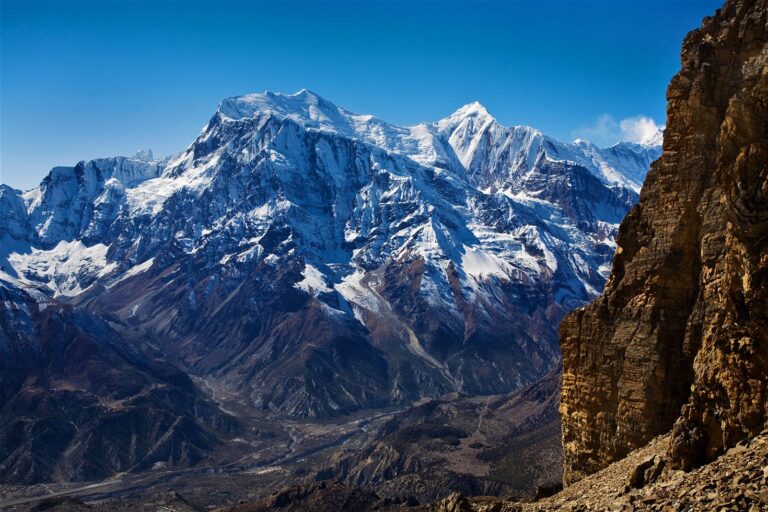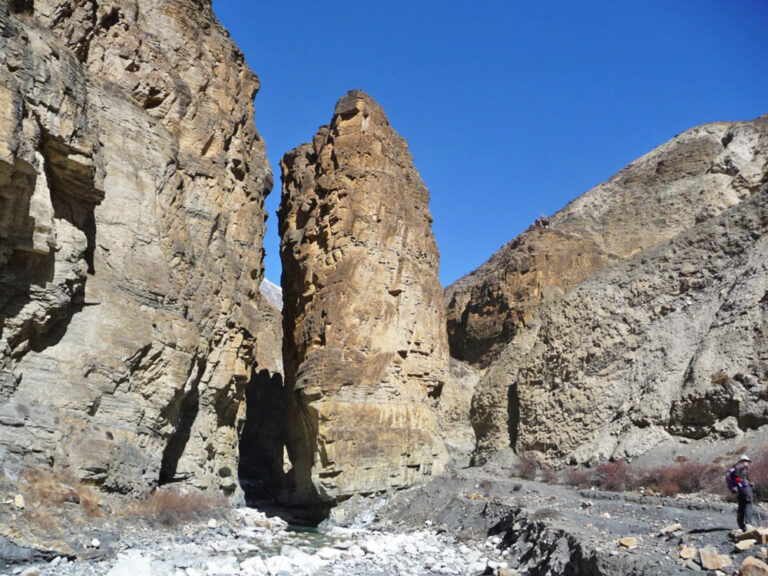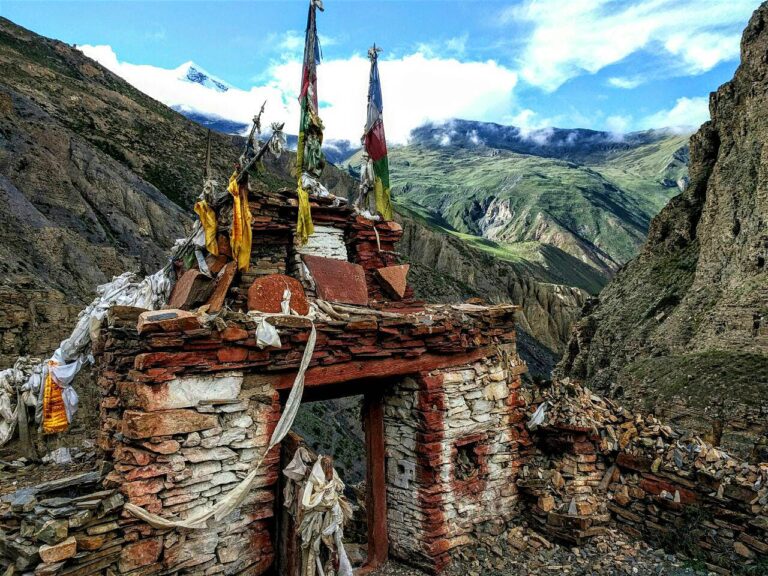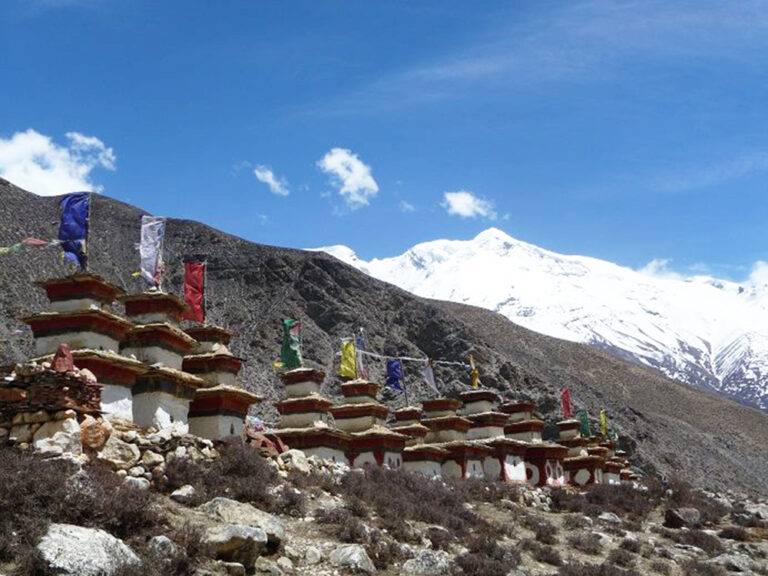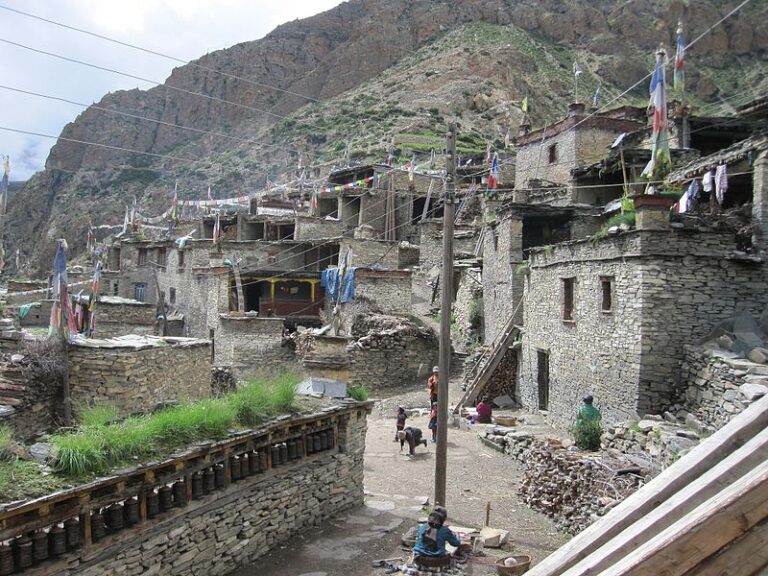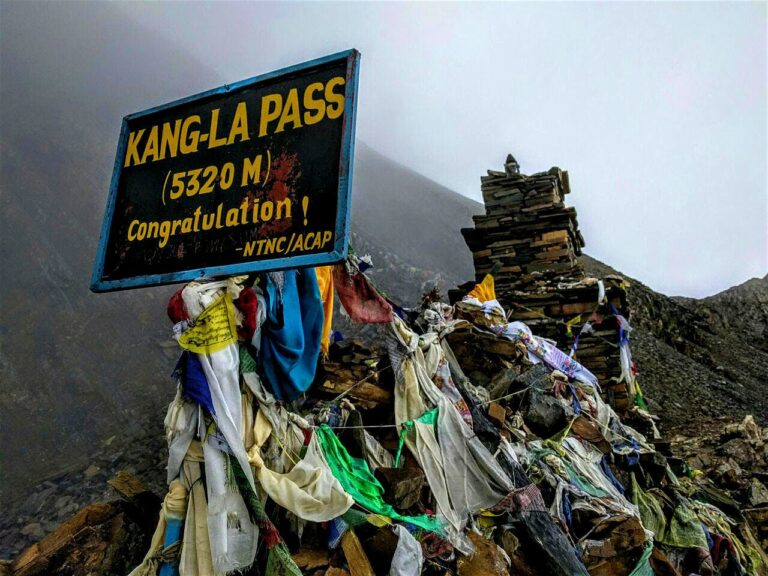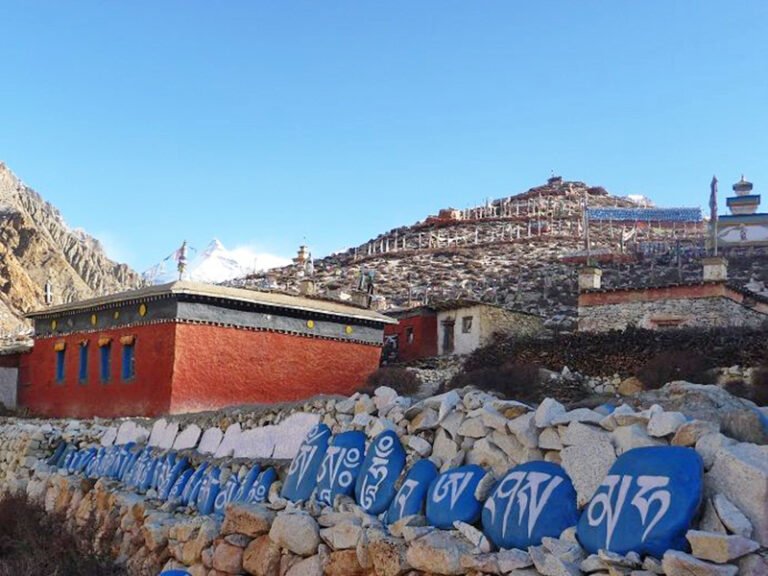Day 01 – On your arrival date at Tribhuwan international airport; your guide will pick you up then escort to the hotel. Your hotel would be the center of the Thamel; which is one of the tourist hubs in Kathmandu.
Day 02 – Sightseeing to the historical and ancient places of Kathmandu city such as Pashupatinath Hindu temple, Baudhanath Stupa, Patan Durbar square, Sawayambhunath Stupa which is also known as monkey temple due to moving hundreds of monkeys. After exploration of these places you will return back to hotel then your guide will brief about trekking trip, trekking itineraries and trekking gears.
Day 03 – Drive to Besishahar and trek to Ngadi village (870m.a.s.l) – 6 hours drive and 3 hours walk – you will drive approximately 6 hours to get Besishahar which is trekking start point for the Nar Phu valley and Annapurna circuit trek. During the driving period; you will have a beautiful view of the terraced field, River valleys, massif views of Annapurna, Ganesh Himal, Manaslu mountain ranges, and dozens of small towns; which are settled just beside the Trisuli River. You will have your lunch in Besishahar then head towards Ngadi village taking by alternative trail instead of motor road. The alternative trail commands you to see the verdant paddy field, green forest, rugged rocky hills, and as well as an awesome view of Marshyangdi River valley.
Day 04 – Trek to Ghermuphat village (1110m.a.s.l)- 6 hours walk – Begin of the morning the trail leads just bank of the Marshyangdi River for one and half hours to get upper Ngadi village then the trail ascends to the Bahundanda village. Normally; trekkers stop in Bahundanda for lunch. Bahundanda is located top of the hill and purpose to see awesome Marshyangdi River valley, Green forest, huge rugged rocky hills, and as well as numerous small villages; which are settled over the vertical land. Trek from Bahundanda to Ghermuphat takes about another two and a half hours and it would be a pleasant walk due to trek on a flat trail and nature views.
Day 05 – Trek to Tal village (1700m.a.s.l) – 6 hours walk – The trail gently descend from the yard of the guesthouse to get Shyange village; which may take about twenty minutes. Shyange village offers to see beautiful waterfalls; which is 109 meters high and falling from the top of the hill. From Shyange village; trekkers have to walk on the road to get Chyamche village. Most of the trekkers stop here for lunch and to see a huge waterfalls and wild honeycombs, hanging on a vertical cliff. After lunch in Chyamche the alternative trail leads towards Tall village pass by Sattale village with the view of rocky hills, waterfalls, and green forest. The trail from Chyamche to Tall is mostly a rocky and climbing up the trail, which may take about three hours to reach in Tal village.
Day 05 – Trek to Timang village (3400m.a.s.l) – 6 hours walk – we will walk just bank of the Marshyangdi River until Danaque village, so the trail is mostly an easy walk cause by flat and gradual climb up. We will pass Siran tall, Dharapani, and Bagarchaap villages with the view of huge green hills, waterfalls, and as well as stunning view of Manaslu. After Danaque village we have to climb up about one and a half hours to get Timang village. If the weather is clear, we can see a closer view of Mount Manaslu to the southwards and Namun peak to the northwards.
Day 06 – Trek to Koto village (2600m.a.s.l) – 3 hours walk – Today we will do just short trek because we can’t go further than Koto village. Trek from Timang to Koto village takes approximately three hours and offers to see a stunning view of Annapurna two and Lamjung Himal. We will have our lunch in Koto Village and in the afternoon we can explore the Chame village and a beautiful monastery and hang around in town.
Day 07 – Trek to Meta village 6 hours walk – The fun of Nar Phu valley trek start from here with full of excitements. The forested and flat trail leads us to Dharmashala with beautiful views of rocky hills, the valley and deep gorge of Nar River, historical cave, stunning view of Lamjung Himal, and huge waterfalls nearby the Dharmashala. Dharmashala is an old inn used by ancient traders of locals and Tibetan peoples. The trail gently ascends from the Dharmashala and an approximately two hours uphill trail brings us to Meta village where we will spend our joyful nights with great hospitality of Gurung people.
Day 08 – Trek to Phu village (4200m.a.s.l)- 6 hours walk – Begins of the morning; we will walk on the flat trail until trail junction to the Nar and Phu village then we will turn to the right-hand side to go Phu village. The gradual and short uphill trail leads us to Phu village pass by three ruin villages called Junam Goth, Chhekya, and Kyang which are ancient settlements of Tibetan refugees called Khampas. While climbing up to Phu village; we will have splendid views of Combi, kangaroo mountain, unique rock formation, enormous pastureland, fascinating landscapes, and as well as hundreds of prayer wheels, Chhortens and entrance gate of Phu village. There are half dozens of guesthouses in Phu village and provides comfortable bedrooms and delicious organic meals.
Day 09 – Exploration day around Phu village – Phu is an ancient Tibetan settlement; which offers so many interesting places and things to see such as monasteries, a handicraft center, stupa, Chhortens, primary school and ruin houses which are made of clay, stones, wooden logs and roofed by the stone slates and soil. Tashi Gompa is a major icon of the Phu village; which was built in the 17th century and well decorated with a colorful Buddhist prayer flag and Mantras. From the yard of Monastery, we will have a massif view of Himlung, Chhuri, Chombi, and Nemjung mountains and its awesome ranges and glaciers.
Day 10 – Trek to Nar Phedi (3490m.a.s.l) – 6 hours walk – There isn’t any alternative trail to get back from Phu village so we will trek down via the same trail until trail junction of to Meta and Nar village then we will turn to the right-hand side to get Nar Phedi. After 10 minutes walk from trail junction appear a wooden bridge call Mahendra Bridge; which is built with rocks and wood over the deep gorge of Nar River. Today, we will sleep in a monastery called Satya Gompa but still the monastery provides bedrooms and basic meals for trekkers and their trekking crews.
Day 11 – Trek to Nar village( 4110 m.a.s.l )- 4 hours walk – The trail gently ascends from the yard of the Monastery and leads us on a rocky steps hills. After two hours of climb up appear an old gate also know as the first Nar gate. During the climbing, we will have fascinating views of Kangaru, Himlung, flying Griffons, and awesome gorge of the Nar River. From the first Nar gate the trail ascends gradually on a ridge and passes by very old chhortens, Stupa, and mani walls. There are dozens of good guest houses in Nar village and offer to have delicious meals with warm hospitality and as well as comfortable bedrooms.
Day 12 – Trek over the Kang-La pass and walk down to Ngawal village (3610 m.a.s.l ) – 7 to 8 hours walk – Some trekkers sleep one overnight in Kang-la phedi which is closer of Kang-La pass so good idea would be to starts trek early in the morning and trek down directly to Ngawal village which may take approximately 7 to 8 hours depends on our walking speed and health condition. We have to climb gradually, 1200 meters to get Kang-La pass which may take 3 to 4 hours. The top of the Kang-La pass commands to see a panoramic view of Annapurna I, II, III, Iv, Gangapurna, Tarke Kang, Khangshar peak, Ticlicho peak, series of Chulu peak, Pisang peak, Kangaru peak, Himlung peak, Lamjung Himal and wonderful Manang valley and Marshyangdi River. From here, we will trek down to Ngawal village through a scree field, juniper bushes with the splendid view of the mountain chain and grazing Yaks and blu sheep. There are dozens of good guesthouses in Ngawal village and offer us to have a delicious meal and comfortable bedrooms.
Day 13 – Trek down to Dhukur Pokhari (3200 m.a.s.l) – 5 hours walk – The morning command us to see the dramatic view of the Annapurna ranges and it’s neighbor’s mountains and glacier. After breakfast, we will walk on the flat trail for one and a half hours to get Ghyaru village with similar mountain views, Pisang valley, and green landscapes. From Ghyaru; the trail gently descends for 45 minutes to get a suspension bridge then the rest of the trail to Dhukur Pokhari is mostly flat and gentle slope. We will stop in Upper Pisang village to have lunch and to explore a beautiful monastery, located top of the village. The yard of Monastery offers to see a grand view of Annapurna II, Pisang peak, Tilicho peak, and wonderful Pisang village valley.
Day 14 – Trek to Chame (2660 m.a.s.l) – 5 hours walk – Our journey starts with splendid views of Annapurna II and Swargadwari Himal(gateway to heaven). The trail to Chame is mostly flat and passes through pine forest although we can see vistas of Annapurna II, Lamjung Himal, and sights of huge rocky hills which are stunning our both hand side. Chame is a small Tibetan village where we can see many interesting things like Stupa, Chortens, colorful mani walls, souvenir shops, and an old monastery. There are dozens of good guesthouses in Chame village which offers comfortable bedrooms.
Day 15 – Drive back to Kathmandu – Chame is connected with Motor road with Besishahar and Kathmandu so we will drive jeep to get Beshishar that may take about three hours. we will have our lunch in Beshishar and continue to drive back to Kathmandu.
Day 16 – Rest day in Kathmandu.
Day 17 – Fly back to Home.
